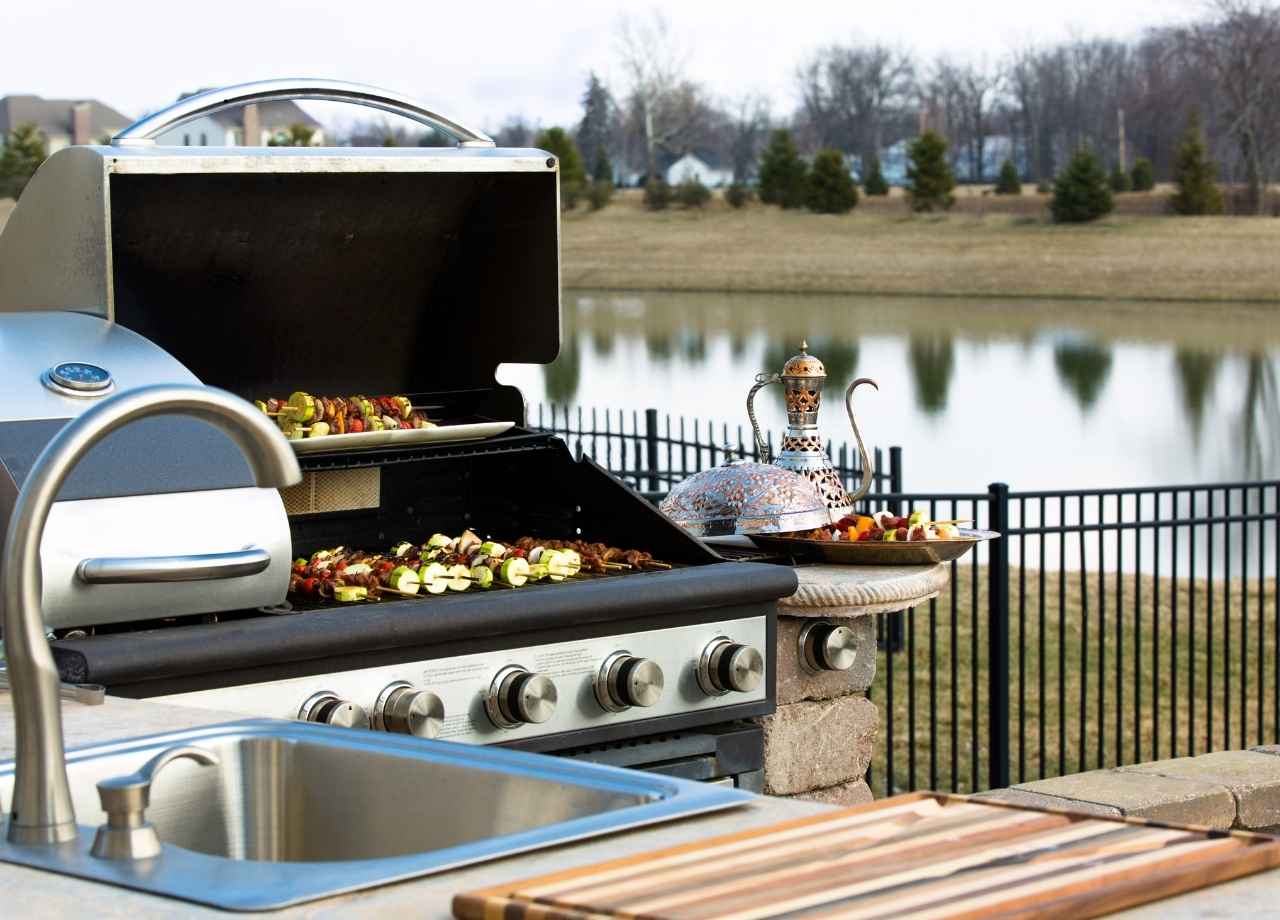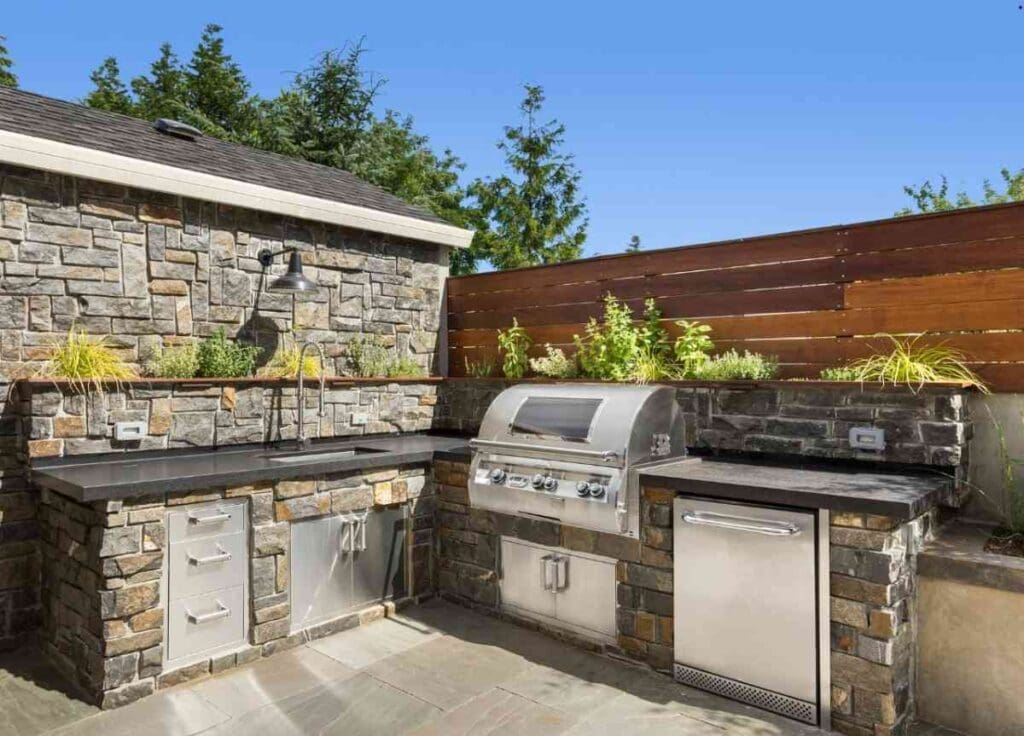
What Is a BBQ Island and Should You Add One to Your Backyard?
Outdoor kitchens have become the centerpiece of backyard living in Jacksonville and across the country. Among the most functional and eye-catching elements in these spaces is the BBQ island. It anchors the outdoor kitchen with structure, utility, and style, creating a permanent cooking station that rivals its indoor counterpart.
At Calico Outdoors, we specialize in custom outdoor kitchens tailored to the North Florida climate, and BBQ islands are often a key feature in those designs. If you’re considering upgrading your backyard, it’s worth understanding what a BBQ island offers and whether it fits your lifestyle.
Table of Contents
Understanding the BBQ Island
A BBQ island is more than just a grill station. It’s a built-in, fixed outdoor structure designed to house a grill along with other integrated cooking, prep, and storage features. Think of it as the foundation of your outdoor kitchen — the permanent structure that holds everything together. It can be simple or elaborate, depending on your space, budget, and how you like to entertain.
At its core, a BBQ island typically includes a grill that’s either gas, charcoal, or hybrid, surrounded by durable construction materials such as stucco, stone veneer, or stainless steel. Most islands also include countertop space, and many homeowners choose to integrate features like side burners, refrigerators, sinks, drawers, and even kegerators.
Unlike freestanding grills or cart-style units, BBQ islands are stationary. They’re usually built on a concrete slab or patio, connected to utilities like gas, water, and electricity. That permanence is part of what gives them a more refined and complete appearance.
Why a BBQ Island is Worth Considering
The appeal of a BBQ island goes beyond looks. Functionality, efficiency, and experience all improve dramatically when cooking outdoors becomes as seamless as it is inside.
One of the biggest advantages is organization. Instead of running back and forth between your indoor kitchen and the grill, everything is within reach. Tools, spices, utensils, prep areas, and storage are all built into the same setup. That convenience translates to smoother, more enjoyable cookouts.
There’s also the matter of durability. When done right, a BBQ island is built to withstand year-round outdoor exposure. That’s especially important in coastal regions like Jacksonville, where sun, humidity, and salt air can take a toll on lower-quality setups. With weather-resistant materials and proper construction, a BBQ island can last for decades with minimal maintenance.
Entertaining is another major reason homeowners choose BBQ islands. They create a natural gathering point. While you’re grilling, guests can hang out nearby at a bar-height counter, sip drinks, and stay engaged. The space becomes more than functional — it becomes social. And because it’s built into the design of your outdoor living area, it visually ties everything together.

Design Considerations Before You Build
A BBQ island isn’t a plug-and-play item. It’s a permanent fixture, which means planning matters. You’ll want to think about how it will be used, how often you entertain, and what kind of cooking you actually enjoy.
Start with the grill. If you’re serious about wood-fired flavor, you might want a charcoal or pellet setup. If speed and control matter more, a gas grill will probably suit you best. Hybrid options give you flexibility, but they’ll also require more space and a larger investment.
Next comes layout. Do you want a straight island that lines up with your patio wall? Or would an L-shaped configuration fit better into a corner? Some homeowners opt for a U-shape to maximize surface area and create a full cooking triangle with separate zones for prep, cook, and serve.
Utility access is another big part of the equation. If you’re including a sink or fridge, you’ll need plumbing and electrical lines. For built-in gas grills, you’ll want either a natural gas hookup or a designated space for a propane tank. These elements affect both cost and construction time.
Material selection matters, too. Granite, concrete, and porcelain tile are common for countertops. Bases can be finished in stacked stone, tile, or stainless steel. Your choices should balance aesthetics, durability, and ease of maintenance. Think about your backyard as a whole — the island should feel like it belongs there.
The Return on Investment
Backyard upgrades often raise the question: will this add value to my home? When it comes to outdoor kitchens, the answer is usually yes. A well-built BBQ island adds curb appeal, functionality, and a sense of luxury that homebuyers increasingly expect — especially in warm-weather markets like Jacksonville.
While exact ROI depends on the quality of the installation and how well it integrates with the rest of your home, many real estate professionals estimate that upscale outdoor kitchens can recoup 60-80% of their cost. That makes it one of the better-performing outdoor projects, especially if it’s part of a cohesive space that includes features like seating areas, lighting, and shade structures.
It’s also worth noting the less tangible benefits. Cooking outdoors keeps heat out of the house during summer. It encourages healthier eating — grilled meats and veggies over fried fare. And it can create a stronger connection to your home, turning mealtime into something you look forward to.
When a BBQ Island Might Not Be Right
Not every backyard is suited for a BBQ island. If you’re renting, for instance, or expect to move in a year or two, a mobile grill cart might make more sense. Space is another consideration. In very small yards or tight patios, a full island could overwhelm the layout and limit flow.
Budget matters, too. A quality BBQ island isn’t cheap — and it shouldn’t be. Cutting corners can lead to problems down the road, from rusted components to unstable framing. If you’re not ready for that investment, it’s better to wait or scale the design to fit your priorities without compromising on materials.
Climate is a factor, although not in the way most people think. Jacksonville’s weather is actually well-suited to year-round outdoor cooking. The real concern is whether the area gets enough use. If you’re rarely outside or don’t enjoy cooking, a built-in island might not earn its keep.
Final Thoughts
A BBQ island can elevate your backyard from basic to exceptional. It blends cooking, design, and social space into one cohesive feature. If you grill often, enjoy entertaining, and want to create a true outdoor kitchen, it’s one of the smartest upgrades you can make.
Just make sure to plan carefully. Focus on layout, materials, and how the space will actually be used. Work with professionals who understand both the technical side of the build and how to design for your climate and lifestyle. Done right, a BBQ island doesn’t just change how you cook — it changes how you live outside.
